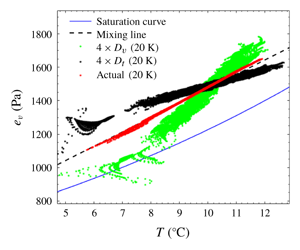Published online by Cambridge University Press: 09 December 2019

Moist Rayleigh–Bénard convection with water saturated boundaries is explored using a One-Dimensional Turbulence model. The system involves both temperature  $T$ and water vapour pressure
$T$ and water vapour pressure  $e_{v}$ as driving scalars. The emphasis of the work is on a supersaturation
$e_{v}$ as driving scalars. The emphasis of the work is on a supersaturation  $s$, a nonlinear combination of
$s$, a nonlinear combination of  $T$ and
$T$ and  $e_{v}$ that is crucial to cloud formation. Its mean as well as fluctuation statistics determine cloud droplet growth and therefore precipitation formation and cloud optical properties. To explore the role of relative scalar diffusivities for temperature (
$e_{v}$ that is crucial to cloud formation. Its mean as well as fluctuation statistics determine cloud droplet growth and therefore precipitation formation and cloud optical properties. To explore the role of relative scalar diffusivities for temperature ( $D_{t}$) and water vapour (
$D_{t}$) and water vapour ( $D_{v}$), three different regimes are considered:
$D_{v}$), three different regimes are considered:  $D_{v}>D_{t}$,
$D_{v}>D_{t}$,  $D_{v}\approx D_{t}$ and
$D_{v}\approx D_{t}$ and  $D_{v}<D_{t}$. Scalar fluxes (Nusselt number,
$D_{v}<D_{t}$. Scalar fluxes (Nusselt number,  $Nu$ and Sherwood number,
$Nu$ and Sherwood number,  $Sh$) and their scalings with moist Rayleigh number
$Sh$) and their scalings with moist Rayleigh number  $Ra_{moist}$ are consistent with previous studies of one-component convection. Moreover, variances of the scalars in the bulk region increase with their diffusivities and also reasonably follow derived scaling expressions. Eulerian properties plotted in
$Ra_{moist}$ are consistent with previous studies of one-component convection. Moreover, variances of the scalars in the bulk region increase with their diffusivities and also reasonably follow derived scaling expressions. Eulerian properties plotted in  $(T,e_{v})$ coordinates have a different slope compared to an idealized mixing process. Additionally, the scalars are highly correlated, even in the cases of high relative diffusivities (factor of four)
$(T,e_{v})$ coordinates have a different slope compared to an idealized mixing process. Additionally, the scalars are highly correlated, even in the cases of high relative diffusivities (factor of four)  $D_{v}$ and
$D_{v}$ and  $D_{t}$. Based on the above fact and the scaling relation of the scalars, the supersaturation variance is found to vary approximately as
$D_{t}$. Based on the above fact and the scaling relation of the scalars, the supersaturation variance is found to vary approximately as  $Ra_{moist}^{5/3}$, in agreement with numerical results. Finally, the supersaturation profile in the boundary layer is explored and compares well with scalar boundary layer models. A sharp peak appears in the boundary-layer-supersaturation profile, not only in the variance but also in the mean profile, due to relative diffusivities of the scalars.
$Ra_{moist}^{5/3}$, in agreement with numerical results. Finally, the supersaturation profile in the boundary layer is explored and compares well with scalar boundary layer models. A sharp peak appears in the boundary-layer-supersaturation profile, not only in the variance but also in the mean profile, due to relative diffusivities of the scalars.